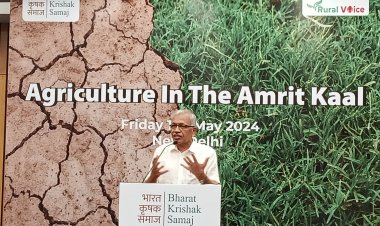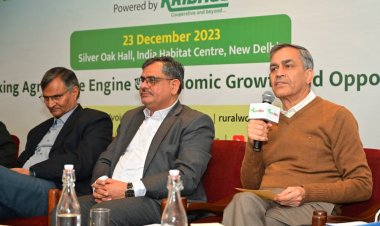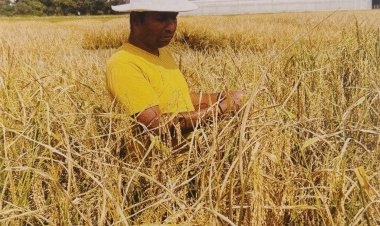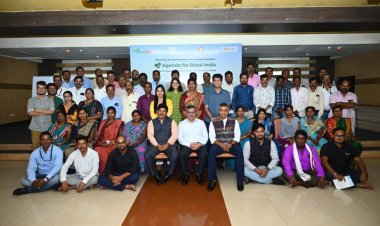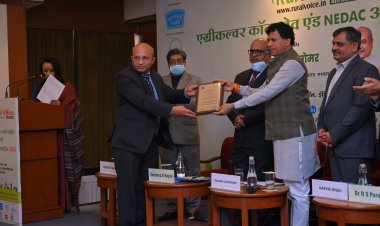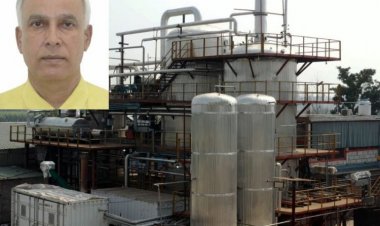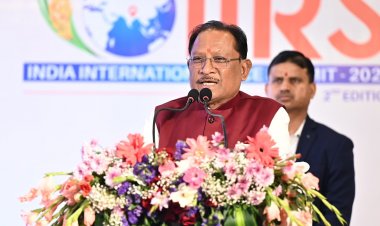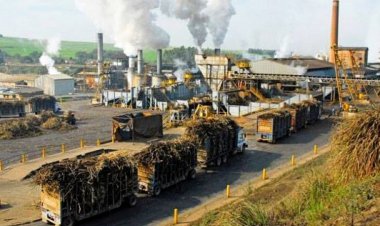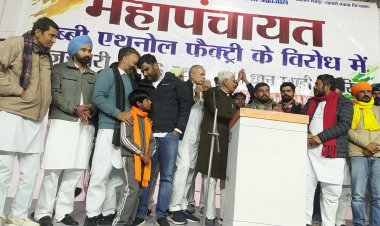New Farm Acts are about Agricultural Transformation: Prof. Ramesh Chand
Professor Ramesh Chand counts among the national and global experts on agricultural policies in the country and on their economic aspects. He has played a key role in formulating the agricultural policies of the present NDA government at the centre and in decisions related to this sector. Besides being Member (Agriculture) of the Niti Aayog, an institution that works on government policies, he is a member of the 15th Finance Commission.

Professor Ramesh Chand counts among the national and global experts on agricultural policies in the country and on their economic aspects. He has played a key role in formulating the agricultural policies of the present NDA government at the centre and in decisions related to this sector. Besides being Member (Agriculture) of the NITI Aayog, an institution that works on government policies, he is a member of the 15th Finance Commission. Agriculture and the three related laws brought by the government are at the centre of dialogue and discourse in the country these days. Rural Voice spoke to Prof. Ramesh Chand at his NITI Aayog office at great length on the future road map for agriculture, new agriculture laws and a host of other issues. Excerpts from the conversation editor Harvir Singh had with Prof. Ramesh Chand for the launching edition of RuralVoice.in:
Q: The country needs a new kind of policy change in the current economic scenario. Dec 23, which is celebrated as Kisan Diwas, is the birthday of former Prime Minister Chaudhary Charan Singh. We have chosen to launch Rural Voice on his birthday. I would like to ask you on this occasion as to how relevant Chaudhari Charan Singh’s economic thoughts and ideas, which had agriculture, farming and farmers at the heart of formulating economic policies, are in the present context. Which includes changes of both policies and laws.
A: Harvir ji, I am glad we are having this conversation on the occasion of Chaudhary Charan Singh’s birthday. I got the chance to hear him twice. When I was an official of the Post Graduate Students’ Union at the Indian Agriculture Institute, we had invited him to the institute. I was deeply influenced by one of his explanations and it is still there in my heart. In which he explained to us the difference between urban and rural areas. What the economists today call “economic disparity”. Replying to a question from a student from urban background, he quipped, “The difference is that even your grandmothers are educated while even our granddaughters are not.” He conveyed to us the complex concept of economic disparity in so simple a manner. This shows his command over difficult economic issues and his grassroots understanding. I have even heard people say that he would ask the farmers to have one eye on the plough and the other on Delhi. By “Delhi” he did not imply the city or its glamour. What he implied was that farmers should have their eyes on the agricultural policies formulated in Delhi. I feel his thoughts become relevant in the present context when some people wish to drive agriculture to a socialist model. Pandit Jawaharlal Nehru, the country’s first prime minister, also indulged in this romanticism. Chaudhary Saheb had then written a book Joint Farming X-rayed, in which he said that the kind of collective farming system or commune system Russia and China had was not possible in India. I would say his greatest message in the present context is that the socialist model should not be brought into the Indian model, in which the farmer loves his land, and policies should be made in view of the circumstances present here. The Asian model is different from the Western one. Large farms have not consumed small ones here. Farmers have small landholdings in the Indian model but they are attached to the land. So, the policies should be made here with a mind open to the farmers’ circumstances. I also call it the Asian model. The Western model does not work in our country because the farmer himself wishes to till the land here.
Q: The country’s economy is currently in recession. Most of the agencies, including the RBI, expect the country’s GDP to contract by 7.5 to 10 per cent. But the growth rate of agriculture and allied sectors continues to be positive. Agriculture is being touted as the “bright spot”. How bright do you think this is?
A: Statistically speaking, the economy is expected to shrink by 7.5 to 10 per cent in the current year. Had agriculture gone the way other sectors did, the shrinkage would have gone up by another 1 per cent. One can’t say that Covid does not affect agriculture. (But) the government allowed agricultural activities to continue and it was my suggestion to the government to exempt agriculture from the lockdown restrictions because it is (such restrictions are) practically not possible in agriculture. So, states had been instructed within three days not to stop agricultural activities. Besides, the nature of work in agriculture is such that social distancing can be maintained. This was also made possible during government purchases in mandis. Thus, better performance in agriculture came as a great help to the economy.
Q: We were struggling with deficit during the Green Revolution. But today, barring a few products like edible oil, we have a surplus. We have become self-dependent even in dals (lentils). Given such a situation, is it time to shift the focus of the government’s agricultural policy from price support to income support?
A: I see it in two ways. Both have their advantages and limitations. You can target the crop with price policy. If you believe there is a need to change the crop pattern, it could be (due to) ecological, natural and economic factors. If you believe rice is a crop that needs too much of water, you may change it (the crop pattern) by means of price policy. Not through income support. You may target price policy at individual entrepreneurship or activity. Income support is crop-neutral. It is economic activity-neutral. Like farmers are being given six thousand rupees these days. This is crop-neutral. Through this you can’t control a crop that is needed less but grown more, as is the case of sugar. Only those get income support who are given this. It is not universal. Price policy can also help you profit other sections of the society. You may benefit the consumer. This is the strength of price policy. It may have positive effects. You may provide food grains to people at concessional rates. The moving away of a country from shortage to surplus does not justify shifting from price policy to income policy, I believe. It would be better to have a mix of the two.
Q: There is much debate going on with respect to MSP. It is determined for only 23 crops and the purchase is done for only half a dozen of them. At the same time, even produces like milk and poultry stare at a market crisis. Given this situation, what should the MSP policy be?
A: While thinking of MSP policy, we should first delve into its origin as to why we need MSP from the government. The reason is that when the farmer does not get a fair price in the market, he turns to the government to seek the right price. The solution to this lies in competition. In which the centre should have responsibility. The states should play a role in implementation. The centre and the states should together work on the issue of what is necessary at the state level. Besides, new methods will have to be devised in issues of requirements of PDS and non-PDS system. The farmers may be provided help in this. In such a situation, the need of farmers should be understood and help extended where required. Because if there is purchase in all cases, it would lead to huge fiscal costs, which is not pragmatic.
Q: The government had promised to fix the MSP at cost plus 50 per cent profit. It is being fixed at 50 per cent profit on the base of A2+FL. But farmer organisations say that the (National) Commission on Farmers headed by M.S. Swaminathan had recommended fixing it at C2 plus 50 per cent profit. Is it possible? If not, what are the practical reasons for this?
A: We should not bind MSP to any single factor. We should not bind it to A2+FL or C2. It could be one of the factors but not the sole one. In order to determine MSP, it is important to know the open market and the international price of a crop. Let me now come to C2. If we add land rent and capital interest to A2+FL, it becomes C2. It is true that your land has an opportunity cost and you should get its rent. But there is no logic in (demanding) a 50 per cent margin above this. If you add 50 per cent to A2+FL, it covers the land rent. This should be covered. But there is no justification of profit over profit and I am ready to talk to my farmer brethren regarding this. MSP should not be less than C2. But the logic of 50 per cent incremental rent on one’s land is not valid.
Q: The government has fixed the target of doubling the farmers’ income by 2022 and only two years are left to achieve this target. How far have we reached on this front? Is it possible to achieve this target by 2022? What will be the basis for this? Has any cut-off year been fixed?
A: Our calculation takes 2016 as the base year. The model APMC Act was brought that year and the model Contract Farming Act a year later. I also got a paper on doubling the farmers’ income published from the Niti Aayog. It had the complete road map. In which there were two factors. One of these was higher price realisation. If this goes up by 8 per cent in five years, the income will go up by 13 per cent. And going up by 10 per cent will lead to an increase in income of 16 per cent. But this is possible only when there is value addition in the produce of the farmers and they have the freedom to sell their produce. The other factor was people moving out of (the profession of) agriculture. What has happened the world over is that people have shifted to non-agriculture sector. The share of farmers in the workforce reduced from 35 per cent to 25 per cent between 2001 and 2011. If this trend continues, one per cent of the farmers will shift out of agriculture every year. If people shift out, this will lead to an increase of income for those who remain there. I believe we shall be able to achieve the target in some of the states. A lot will depend on the pace at which the states have gone by the recommendations of the Niti Aayog. On how many reforms they have implemented.
Q: There is a lot of emphasis on agriculture diversification and a debate is going on. But how will crops be identified for diversification? Which crop should we focus on as we are running a surplus in case of most of the crops? Have we reached a situation similar to that in Europe and the US, where we do not have markets too easily available and (consequently) we have to look for markets?
A: We are in fact heading towards a Europe-like situation. I have given you the examples of sugarcane and sugar, wherein there is a 30 per cent surplus every year. My calculation says that India will have to export a fifth of its production growth every year. Or will have to keep it in storage. But for this you need to watch the market price and competitive situation. If you leave it in the market, prices will fall. In case of diversification, we also need to keep an eye on the consumer trend as to where the consumer is spending. Besides, market signal needs to pe paid heed to. If we do not go for diversification, we shall move in the reverse direction of natural growth process.
Q: Let us now turn to the three agriculture Acts to bring about reforms. Are these laws necessary to bring about a change in agriculture and the condition of farmers? You have played a key role in the legislation. What has been the thinking that has led to implementing laws pertaining to transformation on such a large scale?
A: I have written a paper on this. I am using your forum. I have pointed out 10 reasons for this legislation. The gulf between the income of farmers and that of non-farmers is widening. That needs to be changed. Secondly, the 1991 reforms were focused on industrial and financial sector but we left agriculture out. Thirdly, there have been several farmer agitations over the last few years and their main reason has been the farmers’ unhappiness with the current dispensation hindering their progress. Given such a situation, if we have to take development in agriculture to the next level it is not possible without changing the system. Transformation cannot be brought about without changing the system. You may bring about incremental change but transformation is not possible. I see these laws in the changed context of giving a new shape to the system.
Q: If these are in the interest of the farmers, why are the farmers from the best agricultural regions of the country protesting them? The farmers’ agitation against the laws is turning into the largest agitation of all times. What is the reason behind this? Political parties and farmers both are protesting the laws. Their point is that it was not appropriate to push the legislation in the midst of the pandemic and that too in such a haste. Farmers also allege that they were not consulted at all during the legislation. While the government is now ready to bring about amendments.
A: If we go back a bit in the past (we will find) that it’s only during a crisis that a difficult decision is taken. Everyone was talking about taking Covid as an opportunity. If we look at the 1991 reforms or the Green Revolution of 1966, any momentous decision has been possible only during a crisis. Many people had opposed even the Green Revolution. There was a major hunger crisis, during which it was possible to be brought about. In 1991, the balance-of-payments situation had deteriorated and gold had to be mortgaged. In 2003-04, when cotton production had gone so low that we had to import (it) to run our mills, we had been able to decide on Bt Cotton. Over the last 15-20 years people have been writing about what needs to be done for agriculture and that reforms have to be brought about. Those who have been protesting are doing so only when these ordinances have been issued. Nobody protested reforms before this. Since 2002, I have seen representatives from the agriculture sector advocating for reforms in pre-Budget meetings. So, the government decided to go for it immediately. It is not possible to have consensus on any issue in a democratic system. We are yet to attain consensus on Bt Cotton. The government’s job is to take decisions on the basis of opinions from experts and experience of other countries. I believe that only time will tell whether the decision was correct.
As far as protests from states is concerned, if the states had implemented the amendments to the APMC Act along with the four changes, there would have been no need to bring about a new law. As far as these laws are concerned, the centre has made them for trade. Which is in the Central list and comes under Entry 33. The state governments may, however, impose cess on private trade but they need sanction from the centre for this as these are Central laws. They can, in the name of trade facilitation, protect the mandis from any non-essential competition.
Q: You have vast experience as an agriculture economist. Which direction is agriculture in the country heading in over the coming years? There is an emphasis on its transformation. Obviously, this needs major reforms and changes. What sort of changes should be made and how can consensus be achieved on these?
A: In a new sort of industrial revolution, we need to get away from the Western model and create a new rural development model with agriculture at its core. Jobs will have to be created by establishing agro-processing and industry. Farmers will have to be strengthened by making agriculture self-dependent. The government has a role to play in creating the environment. Institutions will have to be established. Make institutions like the FPO. Farmers will have to be turned into entrepreneurs. Only then can our development model turn successful or we shall be caught in a crisis.
Q: APMC was abolished in Bihar in 2006 but no major private player has arrived there so far. That is being cited as an example. Farmers there have to sell most of their crops below MSP. This is being touted as a major argument against these laws.
A: There is no APMC in Bihar and (but) the new law does not abolish APMC. We should keep both private players and APMC. Punjab has strong mandis but the growth of rice is less than one per cent. In Bihar, there is seven per cent growth without mandi and MSP. But this does not mean we can attribute this growth to the absence of mandis. In fact, every state has unique circumstances. The example of Bihar should not be cited. The APMC exists in the new law. In Bihar it was abolished. I am not in favour of abolishing APMC, which was what Bihar did.
Q: The government desires the corporate to enter agriculture and provide value addition. But should the level of the share of farmers not be fixed in what the consumer pays? Farmers get only 30 to 35 cents out of every dollar paid by the consumer as purchase price in developed countries. Within the country, institutions like Amul are paying up to 70 per cent. Which of these is the ideal condition?
A: There is no formula as such (and the government) cannot mechanically fix it. There are several other factors even in the Amul example. What really matters is the net price the farmers get. I imagine farm as a factory of the farmers. This will benefit the farmers the most.
Q: There is no big public investment in agriculture. Gross capital formation is also less. The government has recently announced an Agri Infra Fund worth one lakh crore. But this is debt while it is being presented as a package.
A: What we call public sector investment comes not only from the centre but also from the states. More than 80 per cent public investment comes from the states. If the states go in for loan waiver and subsidies, this has an adverse effect on public investment in the long run. If we exclude farmers from private investment, the corporate investment is less than 2.5 per cent. We should not see the corporate as enemy sector. It is very important to make it invest in agriculture.
Q: We lag behind a lot in new technology and research in agriculture and most of the new breakthroughs have come from abroad. What is the government policy on GM technology? There seems to be difference of opinion on this within the government itself.
A: It is imperative to go for modernisation of agriculture. Only a combination of investment, knowhow and modernisation can bring about transformation in agriculture. Lateral flow of technology is also necessary. We have missed the bus in horticulture and even fruits like apple are being imported. If we exclude Basmati from the public sector and cotton from the private sector, no big technology has been developed. We should not forget that the Green Revolution in wheat and rice too has been possible only with germplasm from abroad. We should borrow technology from abroad. But, at the same time we should also develop new technology with the help of testing and regulation. We should not depend totally on (technology from) abroad.
Q: Do you think there can be a solution to the ongoing agitation anytime soon? Do you think some change in the laws is possible?
A: Any protracted agitation serves the interest neither of the government nor of the farmers. I pray and hope that a middle path is struck and the crisis resolved. The government has talked on eight reforms, four of which are issues related to these very laws. The government has taken a flexible approach and so should the farmers.
Q: The government is focusing a lot on creating FPOs. Could this not have been done by providing greater autonomy to cooperative committees? Especially when both of them function on the same basic principle, viz. the coming together of farmers to strike a better bargain and minimise costs. There is a limit to the extension of FPOs while the successful institution of cooperatives can be taken to the national level.
A: We need to have several alternatives in a country as diverse as India. FPOs have shown good results at several places. There are various interferences in cooperatives. We should have a combination of FPOs and cooperatives instead of opting for a single model. The states should help the cooperatives prosper and the centre should focus on FPOs. FPOs should be increased in number where there are small landholders.
|
|



 Join the RuralVoice whatsapp group
Join the RuralVoice whatsapp group

















